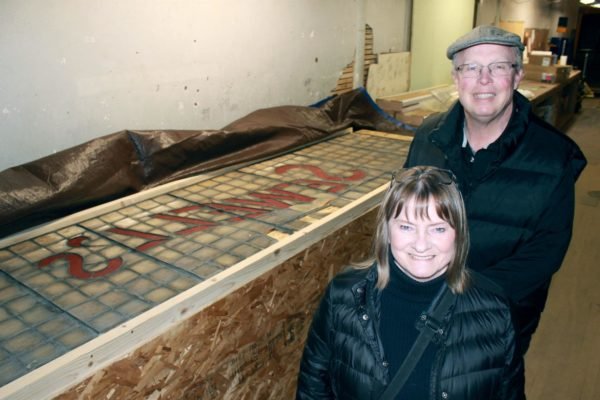Butte organizations, building owner combine forces to restore Sewell's window
Soon the decorative window that has adorned the Sewell’s building on East Park Street for over 100 years will shine a little brighter, thanks to the efforts of volunteers and local historic preservation officials.
The Butte-Silver Bow Historic Preservation Commission, Butte Citizens for Preservation and Revitalization and building owner Joe Floreen are combining forces to enlist Great Falls craftsman Mike Winters to help clean and repair the window, made up of hundreds of pieces of glass tiles.
The tiles, known as Luxfer or prismatic glass, are ribbed on one side and are designed to cast light much farther than traditional flat glass, reducing the need for artificial lighting.
The home of the glass fixture is the transom, an area above the doorway of a building, at 221 E. Park St., a circa 1910s building across the street from Sparky's Garage.
The building was once home to Sewell’s hardware store, which enjoyed a more than 60-year history in Butte.
According to a previous article in The Montana Standard by Butte historian Richard Gibson, Walter J. Sewell started the business sometime before 1911. Eventually the business found its way to the current building at 221 E. Park St., which was built for $5,000 in 1916. After Sewell died in 1952, his son Walter J. Sewell managed the business until he retired and closed the store in 1971.
While Sewell’s hardware store is no more, the window that bears the family name lives on, boasting five panels totaling 30 feet and featuring red stained-glass pieces at its center that spell the Sewell’s name in bold lettering. All of the panels feature an ornamental border of dewdrop prism tiles.
Mary McCormick, the county’s historic preservation officer, noted that after over 100 years of exposure to the Butte elements — “Butte grime,” as she called it — the window is in clear need of some TLC.
Before being taken down in preparation for the upcoming restoration, the fixture was sagging and buckling in some places, while many of the tiles are caked in years of exhaust and dust. Parts of the framing that hold the individual tiles in place also have to be repaired. Called “lead,” the framing is actually made of zinc and has started to crumble in places.
Floreen, the building owner, has been using the building as a warehouse for a book and magazine distribution business. Floreen previously wanted to replace the fixture with a plain window, but after consulting with the Historic Preservation Commission, he decided to partner with the organization and CPR on a restoration project.
“It was really becoming in a dilapidated condition,” said Floreen of the fixture. “It was time,” he added — meaning that it was time to either replace or restore the window.
When all is said and done, the restored prismatic sign will be installed behind a new glass window to protect it from the elements.
Recently, the Sewell project was awarded a $3,250 grant from the Montana History Foundation, which is being administered by the county.
Those funds will go toward hiring Winters who will oversee a group of volunteers to clean and repair the fixture.
Modest in nature, 81-year-old Winters calls himself “proficient” in glasswork, but his wife Barbra isn’t afraid to tell it like she sees it.
“He’s the best craftsman in the state and I’m not kidding,” said Barbra by phone.
As McCormick notes in the grant application for the project, Winters and his wife operated Winters Stained Glass in Great Falls for over 40 years. During that time, the couple built or restored stained glass windows in 42 churches in Montana, among the completion of many other projects.
Recently, Winters’ expertise was enlisted to restore a window in the Belt Theater in northern Montana.
In Butte, Winters will hold six five-hour volunteer workshops, where he’ll instruct volunteers on how to clean, replace deteriorated framing, tamping glass into alignment and soldering the joints of the framing, which is also called “came.” Should all go according to plan, the workshops will start in late May.
Winters said he was honored that a group of individuals in the historic preservation field 150 miles away from his hometown has called on him to help with their project.
“That’s a good feeling,” he said.
Coordinating volunteers will be Lee Whitney, CPR administrative coordinator.
“Pulling volunteers from the community is going to be really significant,” said Whitney, noting the communal nature of the project.
She and McCormick said they see the project not only as a way to get people involved, but also as a way for contractors, builders and other specialists to get some training that they can use on later projects. In all, the group is hoping the project can have a ripple effect.
McCormick said a number of Butte buildings feature similar fixtures in their transoms.
“But this one is so unique because it has the red stained glass and (the Sewell’s) name. And that’s what people are so attached to,” she said.

